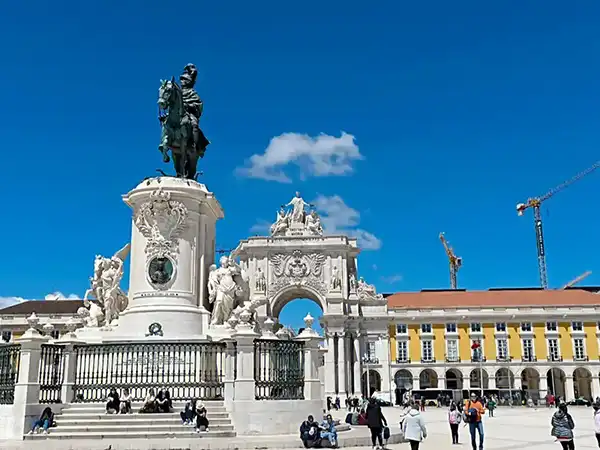Lisbon: Where Ancient Maritime Glory Meets Bohemian Vibrancy
Perched on the edge of the Iberian Peninsula, Lisbon is a city of golden light, terracotta rooftops, and cobblestone alleys that hum with the echoes of explorers, poets, and revolutionaries. As Europe’s westernmost capital, it seamlessly blends medieval charm with contemporary creativity, offering travelers a journey through time—from the Age of Discoveries to today’s thriving arts scene. Whether you’re tracing the footsteps of Vasco da Gama or savoring a custard tart in a sunlit square, Lisbon captivates with its layered history, dramatic landscapes, and infectious energy.
A City Shaped by the Sea and Earthquakes
Lisbon’s identity is inextricably tied to the ocean. In the 15th and 16th centuries, it became the epicenter of global exploration under Prince Henry the Navigator, whose航海学校 in Sagres trained sailors to chart unknown waters. The Belém Tower, a UNESCO World Heritage Site, stands as a testament to this era. Built in 1514 under King Manuel I, this fortress guarded the Tagus River’s entrance and symbolized Portugal’s maritime dominance. Its intricate Manueline architecture—adorned with nautical motifs like twisted ropes and coral—reflects the wealth brought by spice trade routes. Nearby, the Monument to the Discoveries immortalizes explorers such as Vasco da Gama, whose voyage to India in 1497 reshaped global trade. Climb to its rooftop for a view of the Mappa Mundi, a stone mosaic tracing Portugal’s seafaring routes.
The city’s resilience is equally legendary. In 1755, a catastrophic earthquake, followed by a tsunami and fires, destroyed two-thirds of Lisbon. The rebuilt city embraced neoclassical grids in the Baixa district, while surviving landmarks like the Jerónimos Monastery—a Manueline masterpiece funded by da Gama’s spice profits—became symbols of rebirth. Today, the monastery houses Vasco da Gama’s tomb and the Maritime Museum, where astrolabes and ship models evoke Portugal’s golden age.
Modern Creativity in Ancient Alleys
Lisbon’s artistic soul thrives in its juxtapositions. The LX Factory, a revitalized 19th-century industrial complex, now hosts indie galleries, bookshops, and street art murals. Here, you’ll find Ler Devagar (“Read Slowly”), a bookstore set in a former printing press, its shelves towering beneath a suspended bicycle sculpture. For cutting-edge installations, head to MAAT (Museum of Art, Architecture, and Technology), a wave-like structure by the Tagus River that explores the intersection of creativity and sustainability.
The city’s iconic tram 28 isn’t just transportation—it’s a rolling time capsule. Its wooden carriages rattle through Alfama, the oldest district, where laundry flutters between pastel houses and Fado music spills from taverns. At sunset, ascend the Santa Justa Elevator, a neo-Gothic iron marvel, to a panoramic terrace overlooking red-tiled roofs and the river.
Nature’s Drama: Hills, Rivers, and Atlantic Breezes
Lisbon’s “seven hills” offer cinematic vistas. The Miradouro da Senhora do Monte provides a 360-degree view of the city, from the 25 de Abril Bridge (reminiscent of San Francisco’s Golden Gate) to the Cristo Rei statue across the Tagus. For a quieter retreat, the Jardim Botânico Tropical near Belém features exotic palms and peacocks, while the Monsanto Forest Park—Europe’s largest urban green space—invites hiking among pines and prehistoric rock formations.
A short train ride leads to Sintra, a UNESCO-listed fairy-tale landscape. The Pena Palace, a 19th-century Romanticist confection of pastel turrets and Moorish arches, perches atop a misty hill, surrounded by forests of fern and cork oak.
Culinary Traditions: From Convents to Contemporary Markets
Lisbon’s cuisine tells stories of conquest and convent ingenuity. The pastel de nata, a creamy custard tart, was born at Jerónimos Monastery, where monks used egg whites to starch robes, repurposing yolks into desserts. Sample the original at Pastéis de Belém, where queues form daily for flaky, caramelized tarts dusted with cinnamon.
Seafood reigns supreme. At Cervejaria Ramiro, a century-old institution, garlicky clams, tiger prawns, and barnacles are paired with icy Super Bock beer. For a modern twist, Time Out Market in Cais do Sodré gathers 40 vendors under one roof, from Michelin-starred chefs serving octopus rice to artisans crafting ginja (sour cherry liqueur) cocktails.
Shopping: Azulejos, Fashion, and Flea Markets
Lisbon’s retail scene blends tradition and trendiness. In Alfama, family-run shops sell hand-painted azulejos (ceramic tiles) depicting maritime scenes or geometric patterns. The Feira da Ladra flea market, held every Tuesday and Saturday, offers vintage maps, vinyl records, and Art Deco jewelry.
For contemporary design, stroll Avenida da Liberdade, a tree-lined boulevard dotted with luxury boutiques like Claus Porto (artisanal soaps since 1887) and Embaixada, a neo-Moorish palace housing Portuguese designers. In Príncipe Real, concept stores like LX Market showcase upcycled fashion and avant-garde homeware.
Practical Magic: Navigating the City

Lisbon’s charm lies in its walkability, though its hills demand sturdy shoes. The Viva Viagem card offers unlimited access to trams, metro, and ferries for €6.40/day. Skip taxis for scenic rides: the Tram 28 route covers major landmarks, while the Santa Justa Elevator saves climbs to the Chiado district.
Stay in Bairro Alto for nightlife—its cobbled streets buzz with bars playing Fado and electronic beats—or Belém for sunrise views of the tower and monastery.